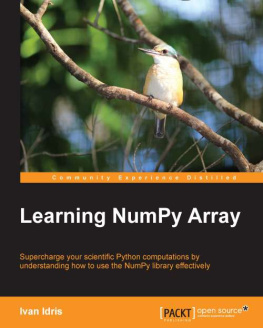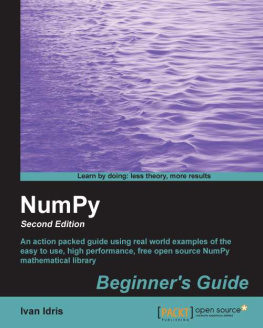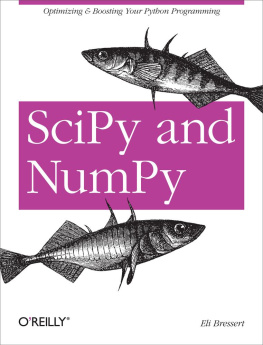Ivan Idris [Ivan Idris] - NumPy: Beginner’s Guide - Third Edition
Here you can read online Ivan Idris [Ivan Idris] - NumPy: Beginner’s Guide - Third Edition full text of the book (entire story) in english for free. Download pdf and epub, get meaning, cover and reviews about this ebook. year: 2015, publisher: Packt Publishing, genre: Computer. Description of the work, (preface) as well as reviews are available. Best literature library LitArk.com created for fans of good reading and offers a wide selection of genres:
Romance novel
Science fiction
Adventure
Detective
Science
History
Home and family
Prose
Art
Politics
Computer
Non-fiction
Religion
Business
Children
Humor
Choose a favorite category and find really read worthwhile books. Enjoy immersion in the world of imagination, feel the emotions of the characters or learn something new for yourself, make an fascinating discovery.
- Book:NumPy: Beginner’s Guide - Third Edition
- Author:
- Publisher:Packt Publishing
- Genre:
- Year:2015
- Rating:3 / 5
- Favourites:Add to favourites
- Your mark:
NumPy: Beginner’s Guide - Third Edition: summary, description and annotation
We offer to read an annotation, description, summary or preface (depends on what the author of the book "NumPy: Beginner’s Guide - Third Edition" wrote himself). If you haven't found the necessary information about the book — write in the comments, we will try to find it.
Build efficient, high-speed programs using the high-performance NumPy mathematical library
About This Book- Written as a step-by-step guide, this book aims to give you a strong foundation in NumPy and breaks down its complex library features into simple tasks
- Perform high performance calculations with clean and efficient NumPy code
- Analyze large datasets with statistical functions and execute complex linear algebra and mathematical computations
This book is for the scientists, engineers, programmers, or analysts looking for a high-quality, open source mathematical library. Knowledge of Python is assumed. Also, some affinity, or at least interest, in mathematics and statistics is required. However, I have provided brief explanations and pointers to learning resources.
What You Will Learn- Install NumPy, matplotlib, SciPy, and IPython on various operating systems
- Use NumPy array objects to perform array operations
- Familiarize yourself with commonly used NumPy functions
- Use NumPy matrices for matrix algebra
- Work with the NumPy modules to perform various algebraic operations
- Test NumPy code with the numpy.testing module
- Plot simple plots, subplots, histograms, and more with matplotlib
In todays world of science and technology, its all about speed and flexibility. When it comes to scientific computing, NumPy tops the list. NumPy will give you both speed and high productivity. This book will walk you through NumPy with clear, step-by-step examples and just the right amount of theory. The book focuses on the fundamentals of NumPy, including array objects, functions, and matrices, each of them explained with practical examples. You will then learn about different NumPy modules while performing mathematical operations such as calculating the Fourier transform, finding the inverse of a matrix, and determining eigenvalues, among many others. This book is a one-stop solution to knowing the ins and outs of the vast NumPy library, empowering you to use its wide range of mathematical features to build efficient, high-speed programs.
**
About the AuthorIvan Idris
Ivan Idris has an MSc in experimental physics. His graduation thesis had a strong emphasis on applied computer science. After graduating, he worked for several companies as a Java developer, data warehouse developer, and QA Analyst. His main professional interests are business intelligence, big data, and cloud computing. Ivan enjoys writing clean, testable code and interesting technical articles. He is the author of NumPy Beginners Guide, NumPy Cookbook, Learning NumPy Array, and Python Data Analysis. You can find more information about him and a blog with a few examples of NumPy at http://ivanidris.net/wordpress/.
Ivan Idris [Ivan Idris]: author's other books
Who wrote NumPy: Beginner’s Guide - Third Edition? Find out the surname, the name of the author of the book and a list of all author's works by series.

![Ivan Idris [Ivan Idris] NumPy: Beginner’s Guide - Third Edition](/uploads/posts/book/119330/thumbs/ivan-idris-ivan-idris-numpy-beginner-s-guide.jpg)
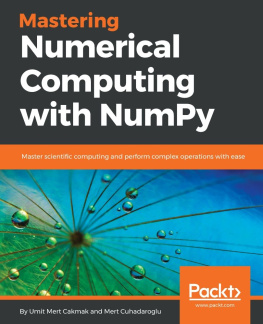
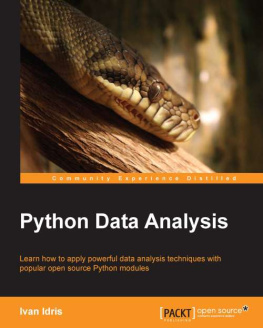
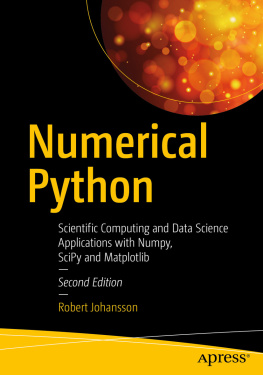

![Eli Bressert [Eli Bressert] - SciPy and NumPy](/uploads/posts/book/119331/thumbs/eli-bressert-eli-bressert-scipy-and-numpy.jpg)
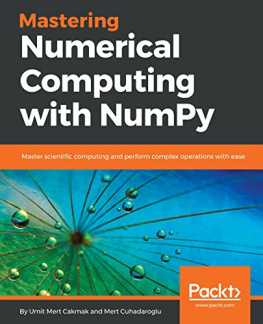
![Ivan Idris [Ivan Idris] - NumPy Cookbook - Second Edition](/uploads/posts/book/119328/thumbs/ivan-idris-ivan-idris-numpy-cookbook-second.jpg)

